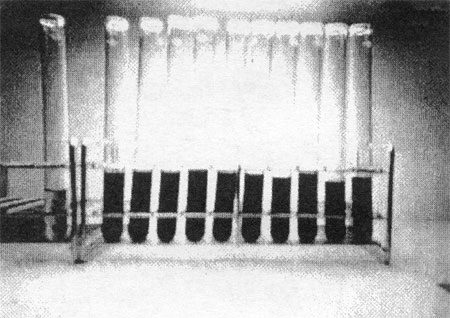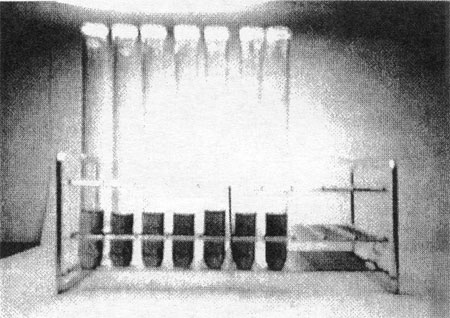(2) Cleaning Speed A test was conducted to compare cleaning speed between a nephron and a conventional filter. The test was made on a small four cycle 1 cylinder diesel engine; 1kw x 2000rpm, D×S = 100mm×100mm. The tested filters are nearly of the same size of 70mm diameter and 100mm length. The conventional filter was one of those exclusively made for the tested engine type. LO samples were taken every 5 hours after the engine was started.
Fig.5 shows the test result. As shown in Fig. 5 (a), all the samples look very black and contaminated after the engine started in case of the conventional filter, while in case of the nephron filter all the samples after engine start look as clean as fresh oil. Fig.5 shows that the nephron filter is very superior to the conventional one in cleaning speed.

(a) Conventional filter
Left sample; Fresh oil, Sampling; every 5hrs

(b) Nephron filter
Left sample; Fresh oil, Sampling; every 5hrs
Fig.5 Comparison of filters
(3) Engine Reliability It is expected that engine reliability is improved with the kidney system because LO is always kept clean. Therefore, a comparison test was carried out by using two oil tanker ships of the same size and type. They were equipped with the engines of the same type; four cycle 6 cylinder diesel engine, 1000kw×720rpm, D×S = 280mm×340mm. They also made voyages almost on the same route between Japan and Percian Gulf. The engines were small ones and originally designed to use marine FO of relatively good quality. However, it was decided to use low grade FO in the engines on the two ships for lower operating cost. The two engines had two engines each. Kidney system was adopted for one of these ships.
Table.3 shows the comparison test results after 16,000 hour running. It is shown that 13 pistons and 239 piston rings were renewed in the engines equipped with the conventional LO system, while there were no piston renewal at all and only 159 piston rings were renewed in the engines equipped with the kidney system. In short, engine reliability was much improved and LO consumption was reduced nearly to half by using the kidney system.
Table 3 Comparison test of reliability

4. ADVANCED FO- LO SYSTEM
The fundamental concept of our R & D is to develope a technology for saving natural resources and environmental protection. In other words it is a technolgy system for (1) minimum use of construction material, (2) longer life of machines, apparatus and so on, (3) minimum or semi-permanent use of consumption resources such as fuel oil (FO) and LO, and (4) minimum or no wastes.
As a nearly ideal engine system of this concept, a cogeneration diesel engine with an advanced FO・LO system has been in practical service at a work shop. It is a four cycle engine of 1000kw×720rpm, D×S = 300mm×320mm using low grade fuel and LO of SAE 30.
BACK CONTENTS NEXT